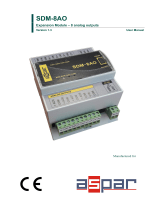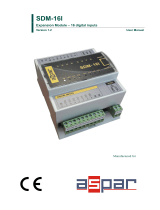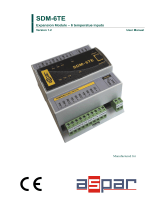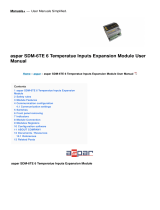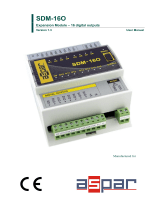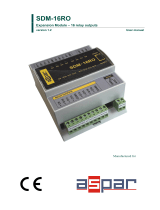Page is loading ...

RS 485 Mini Modbus 1AO
Expansion Module – 1 analog output, 2 digital inputs
Version 1.4 User Manual
Manufactured for

RS485 Mini Modbus 1AO
User Manual
Thank you for choosing our product.
This manual will help you with proper support and proper operation of the device.
The information contained in this manual have been prepared with utmost care by our
professionals and serve as a description of the product without incurring any liability for
the purposes of commercial law.
This information does not release you from the obligation of own judgment and
verification.
We reserve the right to change product specifications without notice.
Please read the instructions carefully and follow the recommendations contained
therein.
WARNING!
Failure to follow instructions can result in equipment damage or impede
the use of the hardware or software.
Expansion Module – 1 analog output, 2 digital inputs
User Manual Version 1.4 2 z 13

RS485 Mini Modbus 1AO
User Manual
1. Safety rules
•Before first use, refer to this manual;
•Before first use, make sure that all cables are connected properly;
•Please ensure proper working conditions, according to the device specifications
(eg: supply voltage, temperature, maximum power consumption);
•Before making any modifications to wiring connections, turn off the power supply.
2. Module Features
2.1. Purpose and description of the module
The MOD-1AO module has 1 current analog output (0-20mA lub 4-20mA) and
1 voltage analog output (0-10V). Both outputs can be used at the same time. The modul
is equipped in two digital inputs. In addition, terminals IN1 and IN2 can be used to
connect one encoder. Setting the output current or voltage value is done via RS485
(Modbus protocol), so you can easily integrate the module with popular PLCs, HMI or
PC equipped with the appropriate adapter.
This module is connected to the RS485 bus with twisted-pair wire.
Communication is via MODBUS RTU or MODBUS ASCII. The use of 32-bit ARM
core processor provides fast processing and quick communication. The baud rate is
configurable from 2400 to 115200.
The module is designed for mounting on a DIN rail in accordance with
DIN EN 5002.
The module is equipped with a set of LEDs used to indicate the status of inputs
and outputs useful for diagnostic purposes and helping to find errors.
Module configuration is done via USB by using a dedicated computer program.
You can also change the parameters using the MODBUS protocol.
Expansion Module – 1 analog output, 2 digital inputs
User Manual Version 1.4 3 z 13

RS485 Mini Modbus 1AO
User Manual
2.2. Technical Specifications
Power supply
Voltage 10-38VDC; 20-28VAC
Maximum Current DC: 90 mA @ 24V
AC: 170 mA @ 24V
Outputs
No of outputs 2
Voltage output 0V do 10V (resolution 1.5mV)
Current output
0mA do 20mA ( resolution 5μA);
4mA do 20mA (value in ‰ – 1000 steps)
(resolution 16μA)
Measurement resolution 12 bits
ADC processing time 16ms / channel
Digital inputs
No of inputs 2
Voltage range 0 – 36V
Low state „0” 0 – 3V
High state „1” 6 – 36V
Input impedance 4kΩ
Isolation 1500 Vrms
Input type PNP or NPN
Counters
No 2
Resolution 32 bits
Frequency 1kHz (max)
Impulse Width 500 μs (min)
Temperature Work -10 °C - +50°C
Storage -40 °C - +85°C
Connectors
Power supply 3 pins
Communication 3 pins
Inputs and Outputs 2 x 3 pins
Configuration Mini USB
Size
Heigth 90 mm
Length 56 mm
Width 17 mm
Interface RS485 UP to 128 devices
Expansion Module – 1 analog output, 2 digital inputs
User Manual Version 1.4 4 z 13

RS485 Mini Modbus 1AO
User Manual
2.3. Dimensions of the product
Look and dimensions of the module are shown below. The module is mounted
directly to the rail in the DIN industry standard.
3. Communication configuration
3.1. Grounding and shielding
In most cases, IO modules will be installed in an enclosure along with other
devices which generate electromagnetic radiation. Examples of these devices are relays
and contactors, transformers, motor controllers etc. This electromagnetic radiation can
induce electrical noise into both power and signal lines, as well as direct radiation into
the module causing negative effects on the system. Appropriate grounding, shielding
and other protective steps should be taken at the installation stage to prevent these
effects. These protective steps include control cabinet grounding, module grounding,
cable shield grounding, protective elements for electromagnetic switching devices,
correct wiring as well as consideration of cable types and their cross sections.
3.2. Network Termination
Transmission line effects often present a problem on data communication
networks. These problems include reflections and signal attenuation.
To eliminate the presence of reflections from the end of the cable, the cable must
be terminated at both ends with a resistor across the line equal to its characteristic
impedance. Both ends must be terminated since the direction of propagation is bi-
directional. In the case of an RS485 twisted pair cable this termination is typically
120 Ω.
Expansion Module – 1 analog output, 2 digital inputs
User Manual Version 1.4 5 z 13
90
17 56
50
34

RS485 Mini Modbus 1AO
User Manual
3.3. Types of Modbus Registers
There are 4 types of variables available in the module
Type Beginning
address Variable Access Modbus
Command
1 00001 Digital Outputs Bit
Read & Write 1, 5, 15
2 10001 Digital Inputs Bit
Read 2
3 30001 Input Registers Registered
Read 3
4 40001 Output Registers Registered
Read & Write 4, 6, 16
3.4. Communication settings
The data stored in the modules memory are in 16-bit registers. Access to
registers is via MODBUS RTU or MODBUS ASCII.
3.4.1. Default settings
Name of parameter Value
Address 1
Baud rate 19200
Parity No
Data bits 8
Stop bits 1
Reply Delay [ms] 0
Modbus type RTU
Expansion Module – 1 analog output, 2 digital inputs
User Manual Version 1.4 6 z 13

RS485 Mini Modbus 1AO
User Manual
3.4.2. Configuration registers
Address Name Values
40002 Module address From 0 to 255
40003 Baud rate 0 – 2400
1 – 4800
2 – 9600
3 – 19200
4 – 38400
5 – 57600
6 – 115200
other – value * 10
40005 Parity 0 – none
1 – odd
2 – even
3 – always 1
4 – always 0
40004 Stop Bits LSB 1 – one stop bit
2 – two stop bits
40004 Data Bits MSB 7 – 7 data bits
8 – 8 data bits
40005 Response Delay Time in ms
40007 Modbus Mode 0 – RTU
1 – ASCII
3.4.3. Watchdog function
This 16-bit register specifies the time in milliseconds to watchdog reset. If module does
not receive any valid message within that time, all Digital and Analog Outputs will be
set to the default state.
This feature is useful if there is an interruption in data transmission and for security
reasons. Output states must be set to the appropriate state in order to assure the safety
of persons or property.
The default value is 0 milliseconds which means the watchdog function is disabled.
Range: 0-65535 ms
Expansion Module – 1 analog output, 2 digital inputs
User Manual Version 1.4 7 z 13

RS485 Mini Modbus 1AO
User Manual
4. Indicators
Indicator Description
ON LED indicates that the module is correctly powered.
TX The LED lights up when the unit received the correct packet and sends the answer.
AOV The LED lights up when the output voltage is non-zero.
AOI The LED lights up when the output current is non-zero.
DI1, DI2 Input state 1, 2
Expansion Module – 1 analog output, 2 digital inputs
User Manual Version 1.4 8 z 13

RS485 Mini Modbus 1AO
User Manual
5. Module Connection
Expansion Module – 1 analog output, 2 digital inputs
User Manual Version 1.4 9 z 13
Power supply
Power supply
Power supply

RS485 Mini Modbus 1AO
User Manual
6. Modules Registers
6.1. Registered access
Address
Modbus Dec Hex Register Name Access Description
30001 0 0x00 Version/Type Read Version and Type of the device
40002 1 0x01 Address Read & Write Module Address
40003 2 0x02 Baud rate Read & Write RS485 baud rate
40004 3 0x03 Stop Bits Read & Write No of Stop bits
40005 4 0x04 Parity Read & Write Parity bit
40006 5 0x05 Response Delay Read & Write Response delay in ms
40007 6 0x06 Modbus Mode Read & Write Modbus Mode (ASCII or RTU)
40009 8 0x09 Watchdog Read & Write Watchdog
40033 32 0x20 Received packets LSB Read & Write No of received packets
40034 33 0x21 Received packets MSB Read & Write
40035 34 0x22 Incorrect packets LSB Read & Write No of received packets with error
40036 35 0x23 Incorrect packets MSB Read & Write
40037 36 0x24 Sent packets LSB Read & Write No of sent packets
40038 37 0x25 Sent packets MSB Read & Write
30051 50 0x32 Inputs Read Input state; Bit is set if value ≠ 0
30052 51 0x33 Outputs Read Output state; Bit is set if value ≠ 0
40053 52 0x34 Current analog output 1 Read & Write
Value of analog output:
inμA for
0 - 20mA (max 20480)
in ‰ for
4-20mA (max 1000)
40054 53 0x35 Voltage analog output 2 Read & Write
Value of analog output:
in mV (max 10240)
40055 54 0x36 Counter 1 LSB Read & Write 32-bit counter 1
40056 55 0x37 Counter 1 MSB Read & Write
40057 56 0x38 Counter2 LSB Read & Write 32-bit counter 2
40058 57 0x39 Counter 2 MSB Read & Write
40059 58 0x3A CounterP 1 LSB Read & Write
32-bit value of captured counter 1
40060 59 0x3B CounterP 1 MSB Read & Write
40061 60 0x3C CounterP 2 LSB Read & Write 32-bit value of captured counter 2
40062 61 0x3D CounterP 2 MSB Read & Write
40063 62 0x3E Catch Read & Write Catch counter
40064 63 0x3F Status Read & Write Captured counter
40065 64 0x40 Default value of 1 analog
current output Read & Write The default of analog output set at power supply and due to
activation of watchdog.
Expansion Module – 1 analog output, 2 digital inputs
User Manual Version 1.4 10 z 13

RS485 Mini Modbus 1AO
User Manual
Address
Modbus Dec Hex Register Name Access Description
40066 65 0x41 Default value of 2 analog
voltage output Read & Write The default of analog output set at power supply and due to
activation of watchdog.
40067 66 0x42 Current analog output 1
configuration Read & Write
Current analog output configuration:
0 – OFF
2 – current output 0-20mA
3 – current output 4-20mA
40068 67 0x43 Voltage analog output 2
configuration Read & Write 0 – OFF
1 – voltage output
40069 68 0x44 Counter Config 1 Read & Write Counters configuration:
+1 – time measurement (if 0 counting impulses)
+2 – autocetch counter every 1 sec
+4 – catch value when input low
+8 – reset counter after catch
+16 – reset counter if input low
+32 – encoder
40070 69 0x45 Counter Config 2 Read & Write
6.2. Bit access
Modbus
Address
Dec
Address
Hex
Address Register Name Access Description
801 800 0x320 Input 1 Read Input 1 state
802 801 0x321 Input 2 Read Input 2 state
817 816 0x330 Output 1 Read Current Analog Output state; Bit is set if
value ≠ 0
818 817 0x331 Output 2 Read Voltage Analog Output state; Bit is set if
value ≠ 0
993 992 0x3E0 Capture 1 Read & Write Capture counter 1
994 993 0x3E1 Capture 1 Read & Write Capture counter 1
1009 1008 0x3F0 Captured 1 Read & Write Captured value of counter 1
1010 1009 0x3F1 Captured 2 Read & Write Captured value of counter 2
Expansion Module – 1 analog output, 2 digital inputs
User Manual Version 1.4 11 z 13

RS485 Mini Modbus 1AO
User Manual
7. Configuration software
Modbus Configurator is software that is designed to set the module registers
responsible for communication over Modbus network as well as to read and write the
current value of other registers of the module. This program can be a convenient way to
test the system as well as to observe real-time changes in the registers. Communication
with the module is done via the USB cable. The module does not require any drivers
Configurator is a universal program, whereby it is possible to configure all
available modules.
Expansion Module – 1 analog output, 2 digital inputs
User Manual Version 1.4 12 z 13
USB Cable
Modbus
Module

RS485 Mini Modbus 1AO
User Manual
Spis treści
1. Safety rules......................................................................................................................................3
2. Module Features..............................................................................................................................3
2.1. Purpose and description of the module....................................................................................3
2.2. Technical Specifications..........................................................................................................4
2.3. Dimensions of the product.......................................................................................................5
3. Communication configuration.........................................................................................................5
3.1. Grounding and shielding..........................................................................................................5
3.2. Network Termination...............................................................................................................5
3.3. Types of Modbus Registers......................................................................................................6
3.4. Communication settings..........................................................................................................6
3.4.1. Default settings................................................................................................................6
3.4.2. Configuration registers.....................................................................................................7
3.4.3. Watchdog function...........................................................................................................7
4. Indicators.........................................................................................................................................8
5. Module Connection.........................................................................................................................9
6. Modules Registers.........................................................................................................................10
6.1. Registered access...................................................................................................................10
6.2. Bit access...............................................................................................................................11
7. Configuration software..................................................................................................................12
Manufactured for:
Aspar s.c.
ul. Oliwska 112
80-209 Chwaszczyno
POLAND
ampero@ampero.eu
www.ampero.eu
tel. +48 58 351 39 89; +48 58 732 71 73
Expansion Module – 1 analog output, 2 digital inputs
User Manual Version 1.4 13 z 13
/
